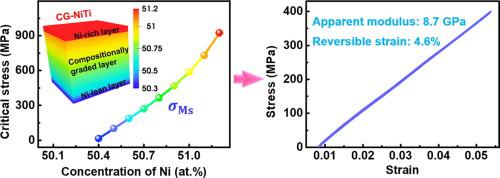当前位置:
X-MOL 学术
›
Mater. Today
›
论文详情
Our official English website, www.x-mol.net, welcomes your feedback! (Note: you will need to create a separate account there.)
Linear-superelastic metals by controlled strain release via nanoscale concentration-gradient engineering
Materials Today ( IF 24.2 ) Pub Date : 2020-03-01 , DOI: 10.1016/j.mattod.2019.10.003 Jiaming Zhu , Dong Wang , Yipeng Gao , Tong-Yi Zhang , Yunzhi Wang
Materials Today ( IF 24.2 ) Pub Date : 2020-03-01 , DOI: 10.1016/j.mattod.2019.10.003 Jiaming Zhu , Dong Wang , Yipeng Gao , Tong-Yi Zhang , Yunzhi Wang

|
Abstract The elastic strain limit of most metals are less than 0.2% except for whiskers or freestanding nanowires whose elastic strain limit could reach 4–7%. Ferroelastic metals such as shape memory alloys (SMAs) do exhibit giant recoverable strains (up to ∼13%). However, the strong non-linear pseudo-elasticity of SMAs leads to mechanical instability. By taking advantage of the strong composition-dependent critical stress for stress-induced martensitic transformation (MT) in NiTi SMA, this work demonstrates a novel design approach to achieve linear-superelasticity (∼4.6%) and ultralow modulus (8.7 GPa) of a NiTi single crystal. These unprecedented properties are realized through precisely controlling strain release during the MT via nanoscale concentration-gradient engineering. The computer simulation results and theoretical analyses reveal that the stress–strain behavior of NiTi and other SMAs can be regulated effectively by fine-tuning the concentration gradient. This may open a new avenue for the design of next generation ferroelastic materials.
中文翻译:

通过纳米级浓度梯度工程控制应变释放的线性超弹性金属
摘要 除了晶须或独立纳米线的弹性应变极限可达到 4-7% 外,大多数金属的弹性应变极限小于 0.2%。形状记忆合金 (SMA) 等铁弹性金属确实表现出巨大的可恢复应变(高达 13%)。然而,SMA 的强非线性伪弹性会导致机械不稳定。通过利用 NiTi SMA 中应力诱导马氏体转变 (MT) 的强成分相关临界应力,这项工作展示了一种新颖的设计方法,可实现线性超弹性 (~4.6%) 和超低模量 (8.7 GPa)。镍钛单晶。这些前所未有的特性是通过纳米级浓度梯度工程精确控制 MT 过程中的应变释放来实现的。计算机模拟结果和理论分析表明,可以通过微调浓度梯度来有效调节 NiTi 和其他 SMA 的应力应变行为。这可能为下一代铁弹性材料的设计开辟一条新途径。
更新日期:2020-03-01
中文翻译:

通过纳米级浓度梯度工程控制应变释放的线性超弹性金属
摘要 除了晶须或独立纳米线的弹性应变极限可达到 4-7% 外,大多数金属的弹性应变极限小于 0.2%。形状记忆合金 (SMA) 等铁弹性金属确实表现出巨大的可恢复应变(高达 13%)。然而,SMA 的强非线性伪弹性会导致机械不稳定。通过利用 NiTi SMA 中应力诱导马氏体转变 (MT) 的强成分相关临界应力,这项工作展示了一种新颖的设计方法,可实现线性超弹性 (~4.6%) 和超低模量 (8.7 GPa)。镍钛单晶。这些前所未有的特性是通过纳米级浓度梯度工程精确控制 MT 过程中的应变释放来实现的。计算机模拟结果和理论分析表明,可以通过微调浓度梯度来有效调节 NiTi 和其他 SMA 的应力应变行为。这可能为下一代铁弹性材料的设计开辟一条新途径。



























 京公网安备 11010802027423号
京公网安备 11010802027423号